Mad Cow Disease: Analysis of the Food Crisis and Its Impact
VerifiedAdded on 2021/04/17
|8
|3603
|425
Report
AI Summary
This report provides a comprehensive analysis of the BSE (Bovine Spongiform Encephalopathy) outbreak, also known as Mad Cow Disease, and its devastating impact on the food supply and public trust. The report details the initial outbreak in the UK, the symptoms of the disease in cattle, and the role of prions in its transmission. It examines the critical analysis of the scandal, including the long maturation period, transmission through contaminated meat and bone meal, and the lack of initial understanding of the disease. The report highlights the roles of major actors in the supply chain, including government departments, local authorities, the beef industry, and the public, and how their conflicting responsibilities and actions influenced the crisis. It further explores the government's efforts to restore public trust, including the introduction of feed bans and specific risk material controls, while also addressing the risk management deficits and misrepresentation of information. Finally, the report analyzes the policy changes implemented in response to the outbreak, such as the ruminant feed ban and the specified bovine offal ban (SBO ban), and their effectiveness in controlling the spread of the disease, including delays in implementing bans and the impact of government confidentiality. The report concludes with an overview of the impact on public health and food safety regulations.
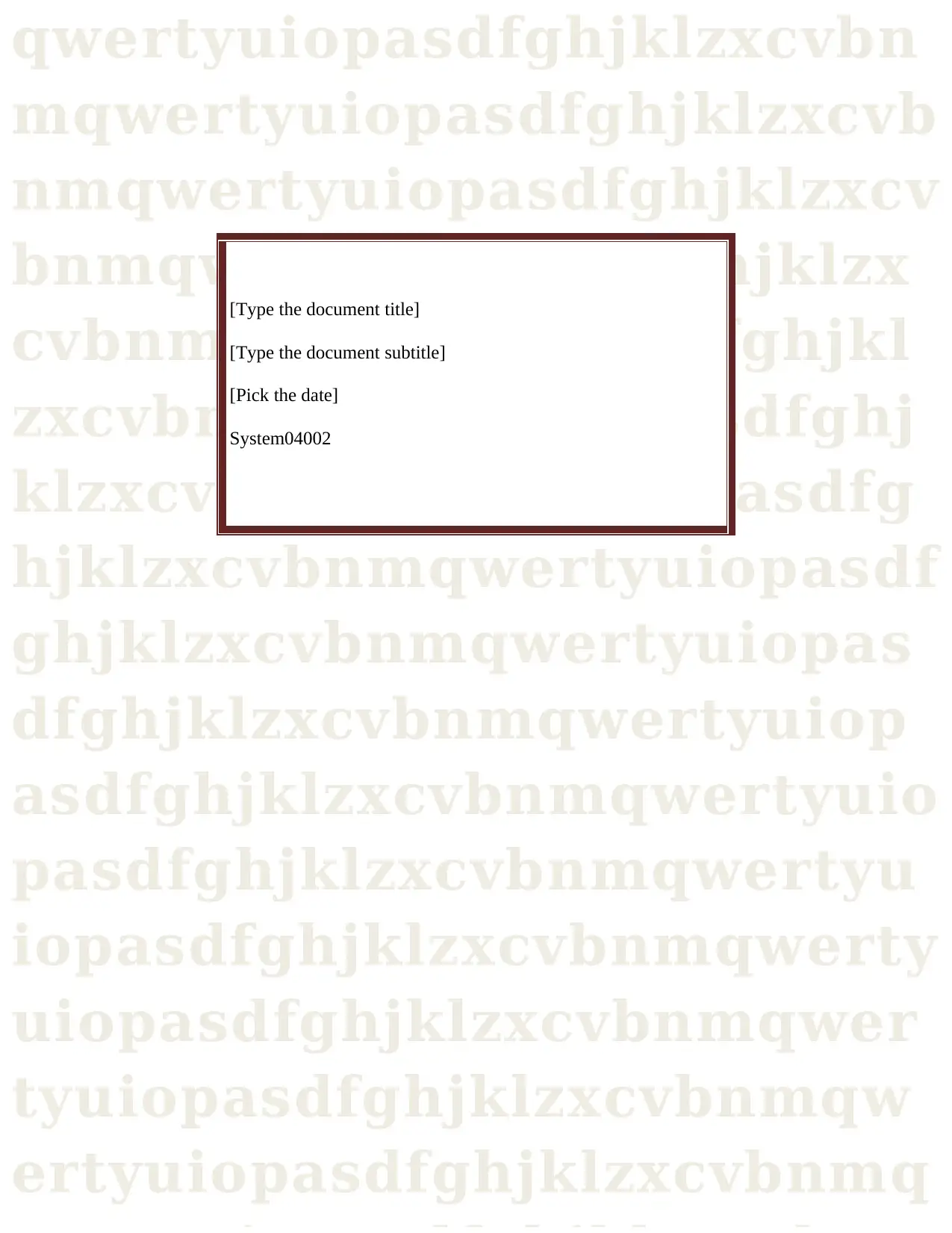
qwertyuiopasdfghjklzxcvbn
mqwertyuiopasdfghjklzxcvb
nmqwertyuiopasdfghjklzxcv
bnmqwertyuiopasdfghjklzx
cvbnmqwertyuiopasdfghjkl
zxcvbnmqwertyuiopasdfghj
klzxcvbnmqwertyuiopasdfg
hjklzxcvbnmqwertyuiopasdf
ghjklzxcvbnmqwertyuiopas
dfghjklzxcvbnmqwertyuiop
asdfghjklzxcvbnmqwertyuio
pasdfghjklzxcvbnmqwertyu
iopasdfghjklzxcvbnmqwerty
uiopasdfghjklzxcvbnmqwer
tyuiopasdfghjklzxcvbnmqw
ertyuiopasdfghjklzxcvbnmq
[Type the document title]
[Type the document subtitle]
[Pick the date]
System04002
mqwertyuiopasdfghjklzxcvb
nmqwertyuiopasdfghjklzxcv
bnmqwertyuiopasdfghjklzx
cvbnmqwertyuiopasdfghjkl
zxcvbnmqwertyuiopasdfghj
klzxcvbnmqwertyuiopasdfg
hjklzxcvbnmqwertyuiopasdf
ghjklzxcvbnmqwertyuiopas
dfghjklzxcvbnmqwertyuiop
asdfghjklzxcvbnmqwertyuio
pasdfghjklzxcvbnmqwertyu
iopasdfghjklzxcvbnmqwerty
uiopasdfghjklzxcvbnmqwer
tyuiopasdfghjklzxcvbnmqw
ertyuiopasdfghjklzxcvbnmq
[Type the document title]
[Type the document subtitle]
[Pick the date]
System04002
Paraphrase This Document
Need a fresh take? Get an instant paraphrase of this document with our AI Paraphraser
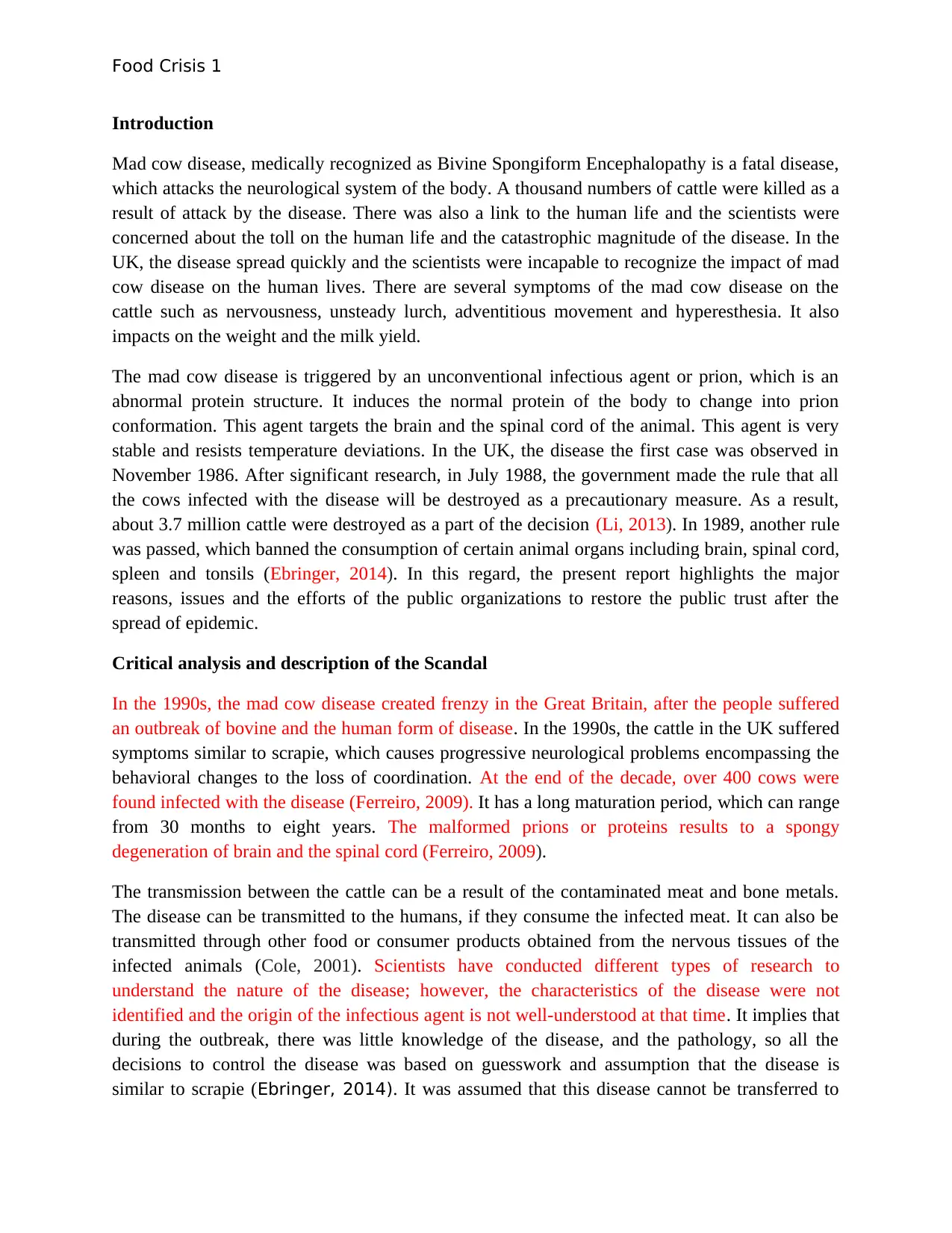
Food Crisis 1
Introduction
Mad cow disease, medically recognized as Bivine Spongiform Encephalopathy is a fatal disease,
which attacks the neurological system of the body. A thousand numbers of cattle were killed as a
result of attack by the disease. There was also a link to the human life and the scientists were
concerned about the toll on the human life and the catastrophic magnitude of the disease. In the
UK, the disease spread quickly and the scientists were incapable to recognize the impact of mad
cow disease on the human lives. There are several symptoms of the mad cow disease on the
cattle such as nervousness, unsteady lurch, adventitious movement and hyperesthesia. It also
impacts on the weight and the milk yield.
The mad cow disease is triggered by an unconventional infectious agent or prion, which is an
abnormal protein structure. It induces the normal protein of the body to change into prion
conformation. This agent targets the brain and the spinal cord of the animal. This agent is very
stable and resists temperature deviations. In the UK, the disease the first case was observed in
November 1986. After significant research, in July 1988, the government made the rule that all
the cows infected with the disease will be destroyed as a precautionary measure. As a result,
about 3.7 million cattle were destroyed as a part of the decision (Li, 2013). In 1989, another rule
was passed, which banned the consumption of certain animal organs including brain, spinal cord,
spleen and tonsils (Ebringer, 2014). In this regard, the present report highlights the major
reasons, issues and the efforts of the public organizations to restore the public trust after the
spread of epidemic.
Critical analysis and description of the Scandal
In the 1990s, the mad cow disease created frenzy in the Great Britain, after the people suffered
an outbreak of bovine and the human form of disease. In the 1990s, the cattle in the UK suffered
symptoms similar to scrapie, which causes progressive neurological problems encompassing the
behavioral changes to the loss of coordination. At the end of the decade, over 400 cows were
found infected with the disease (Ferreiro, 2009). It has a long maturation period, which can range
from 30 months to eight years. The malformed prions or proteins results to a spongy
degeneration of brain and the spinal cord (Ferreiro, 2009).
The transmission between the cattle can be a result of the contaminated meat and bone metals.
The disease can be transmitted to the humans, if they consume the infected meat. It can also be
transmitted through other food or consumer products obtained from the nervous tissues of the
infected animals (Cole, 2001). Scientists have conducted different types of research to
understand the nature of the disease; however, the characteristics of the disease were not
identified and the origin of the infectious agent is not well-understood at that time. It implies that
during the outbreak, there was little knowledge of the disease, and the pathology, so all the
decisions to control the disease was based on guesswork and assumption that the disease is
similar to scrapie (Ebringer, 2014). It was assumed that this disease cannot be transferred to
Introduction
Mad cow disease, medically recognized as Bivine Spongiform Encephalopathy is a fatal disease,
which attacks the neurological system of the body. A thousand numbers of cattle were killed as a
result of attack by the disease. There was also a link to the human life and the scientists were
concerned about the toll on the human life and the catastrophic magnitude of the disease. In the
UK, the disease spread quickly and the scientists were incapable to recognize the impact of mad
cow disease on the human lives. There are several symptoms of the mad cow disease on the
cattle such as nervousness, unsteady lurch, adventitious movement and hyperesthesia. It also
impacts on the weight and the milk yield.
The mad cow disease is triggered by an unconventional infectious agent or prion, which is an
abnormal protein structure. It induces the normal protein of the body to change into prion
conformation. This agent targets the brain and the spinal cord of the animal. This agent is very
stable and resists temperature deviations. In the UK, the disease the first case was observed in
November 1986. After significant research, in July 1988, the government made the rule that all
the cows infected with the disease will be destroyed as a precautionary measure. As a result,
about 3.7 million cattle were destroyed as a part of the decision (Li, 2013). In 1989, another rule
was passed, which banned the consumption of certain animal organs including brain, spinal cord,
spleen and tonsils (Ebringer, 2014). In this regard, the present report highlights the major
reasons, issues and the efforts of the public organizations to restore the public trust after the
spread of epidemic.
Critical analysis and description of the Scandal
In the 1990s, the mad cow disease created frenzy in the Great Britain, after the people suffered
an outbreak of bovine and the human form of disease. In the 1990s, the cattle in the UK suffered
symptoms similar to scrapie, which causes progressive neurological problems encompassing the
behavioral changes to the loss of coordination. At the end of the decade, over 400 cows were
found infected with the disease (Ferreiro, 2009). It has a long maturation period, which can range
from 30 months to eight years. The malformed prions or proteins results to a spongy
degeneration of brain and the spinal cord (Ferreiro, 2009).
The transmission between the cattle can be a result of the contaminated meat and bone metals.
The disease can be transmitted to the humans, if they consume the infected meat. It can also be
transmitted through other food or consumer products obtained from the nervous tissues of the
infected animals (Cole, 2001). Scientists have conducted different types of research to
understand the nature of the disease; however, the characteristics of the disease were not
identified and the origin of the infectious agent is not well-understood at that time. It implies that
during the outbreak, there was little knowledge of the disease, and the pathology, so all the
decisions to control the disease was based on guesswork and assumption that the disease is
similar to scrapie (Ebringer, 2014). It was assumed that this disease cannot be transferred to
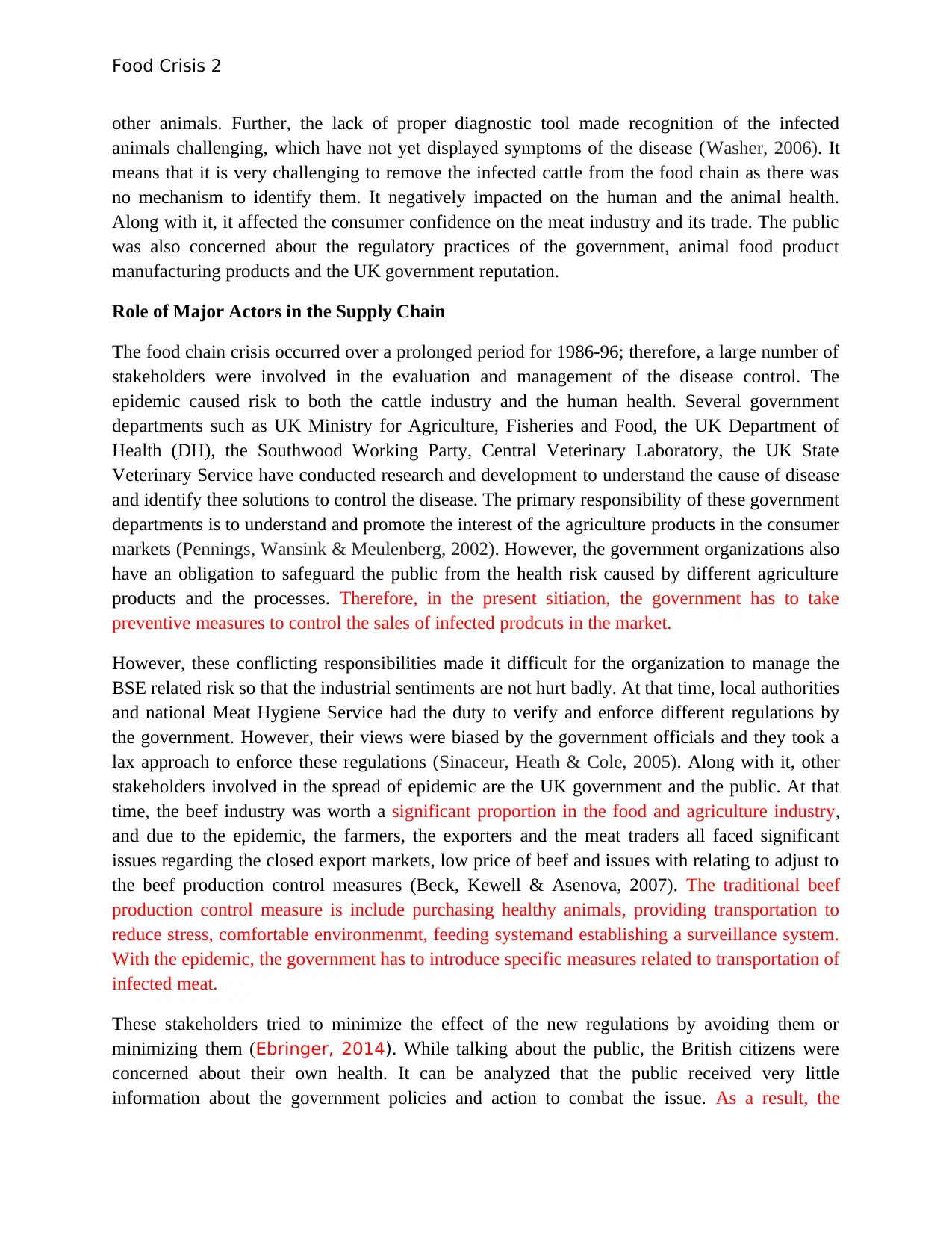
Food Crisis 2
other animals. Further, the lack of proper diagnostic tool made recognition of the infected
animals challenging, which have not yet displayed symptoms of the disease (Washer, 2006). It
means that it is very challenging to remove the infected cattle from the food chain as there was
no mechanism to identify them. It negatively impacted on the human and the animal health.
Along with it, it affected the consumer confidence on the meat industry and its trade. The public
was also concerned about the regulatory practices of the government, animal food product
manufacturing products and the UK government reputation.
Role of Major Actors in the Supply Chain
The food chain crisis occurred over a prolonged period for 1986-96; therefore, a large number of
stakeholders were involved in the evaluation and management of the disease control. The
epidemic caused risk to both the cattle industry and the human health. Several government
departments such as UK Ministry for Agriculture, Fisheries and Food, the UK Department of
Health (DH), the Southwood Working Party, Central Veterinary Laboratory, the UK State
Veterinary Service have conducted research and development to understand the cause of disease
and identify thee solutions to control the disease. The primary responsibility of these government
departments is to understand and promote the interest of the agriculture products in the consumer
markets (Pennings, Wansink & Meulenberg, 2002). However, the government organizations also
have an obligation to safeguard the public from the health risk caused by different agriculture
products and the processes. Therefore, in the present sitiation, the government has to take
preventive measures to control the sales of infected prodcuts in the market.
However, these conflicting responsibilities made it difficult for the organization to manage the
BSE related risk so that the industrial sentiments are not hurt badly. At that time, local authorities
and national Meat Hygiene Service had the duty to verify and enforce different regulations by
the government. However, their views were biased by the government officials and they took a
lax approach to enforce these regulations (Sinaceur, Heath & Cole, 2005). Along with it, other
stakeholders involved in the spread of epidemic are the UK government and the public. At that
time, the beef industry was worth a significant proportion in the food and agriculture industry,
and due to the epidemic, the farmers, the exporters and the meat traders all faced significant
issues regarding the closed export markets, low price of beef and issues with relating to adjust to
the beef production control measures (Beck, Kewell & Asenova, 2007). The traditional beef
production control measure is include purchasing healthy animals, providing transportation to
reduce stress, comfortable environmenmt, feeding systemand establishing a surveillance system.
With the epidemic, the government has to introduce specific measures related to transportation of
infected meat.
These stakeholders tried to minimize the effect of the new regulations by avoiding them or
minimizing them (Ebringer, 2014). While talking about the public, the British citizens were
concerned about their own health. It can be analyzed that the public received very little
information about the government policies and action to combat the issue. As a result, the
other animals. Further, the lack of proper diagnostic tool made recognition of the infected
animals challenging, which have not yet displayed symptoms of the disease (Washer, 2006). It
means that it is very challenging to remove the infected cattle from the food chain as there was
no mechanism to identify them. It negatively impacted on the human and the animal health.
Along with it, it affected the consumer confidence on the meat industry and its trade. The public
was also concerned about the regulatory practices of the government, animal food product
manufacturing products and the UK government reputation.
Role of Major Actors in the Supply Chain
The food chain crisis occurred over a prolonged period for 1986-96; therefore, a large number of
stakeholders were involved in the evaluation and management of the disease control. The
epidemic caused risk to both the cattle industry and the human health. Several government
departments such as UK Ministry for Agriculture, Fisheries and Food, the UK Department of
Health (DH), the Southwood Working Party, Central Veterinary Laboratory, the UK State
Veterinary Service have conducted research and development to understand the cause of disease
and identify thee solutions to control the disease. The primary responsibility of these government
departments is to understand and promote the interest of the agriculture products in the consumer
markets (Pennings, Wansink & Meulenberg, 2002). However, the government organizations also
have an obligation to safeguard the public from the health risk caused by different agriculture
products and the processes. Therefore, in the present sitiation, the government has to take
preventive measures to control the sales of infected prodcuts in the market.
However, these conflicting responsibilities made it difficult for the organization to manage the
BSE related risk so that the industrial sentiments are not hurt badly. At that time, local authorities
and national Meat Hygiene Service had the duty to verify and enforce different regulations by
the government. However, their views were biased by the government officials and they took a
lax approach to enforce these regulations (Sinaceur, Heath & Cole, 2005). Along with it, other
stakeholders involved in the spread of epidemic are the UK government and the public. At that
time, the beef industry was worth a significant proportion in the food and agriculture industry,
and due to the epidemic, the farmers, the exporters and the meat traders all faced significant
issues regarding the closed export markets, low price of beef and issues with relating to adjust to
the beef production control measures (Beck, Kewell & Asenova, 2007). The traditional beef
production control measure is include purchasing healthy animals, providing transportation to
reduce stress, comfortable environmenmt, feeding systemand establishing a surveillance system.
With the epidemic, the government has to introduce specific measures related to transportation of
infected meat.
These stakeholders tried to minimize the effect of the new regulations by avoiding them or
minimizing them (Ebringer, 2014). While talking about the public, the British citizens were
concerned about their own health. It can be analyzed that the public received very little
information about the government policies and action to combat the issue. As a result, the
⊘ This is a preview!⊘
Do you want full access?
Subscribe today to unlock all pages.

Trusted by 1+ million students worldwide
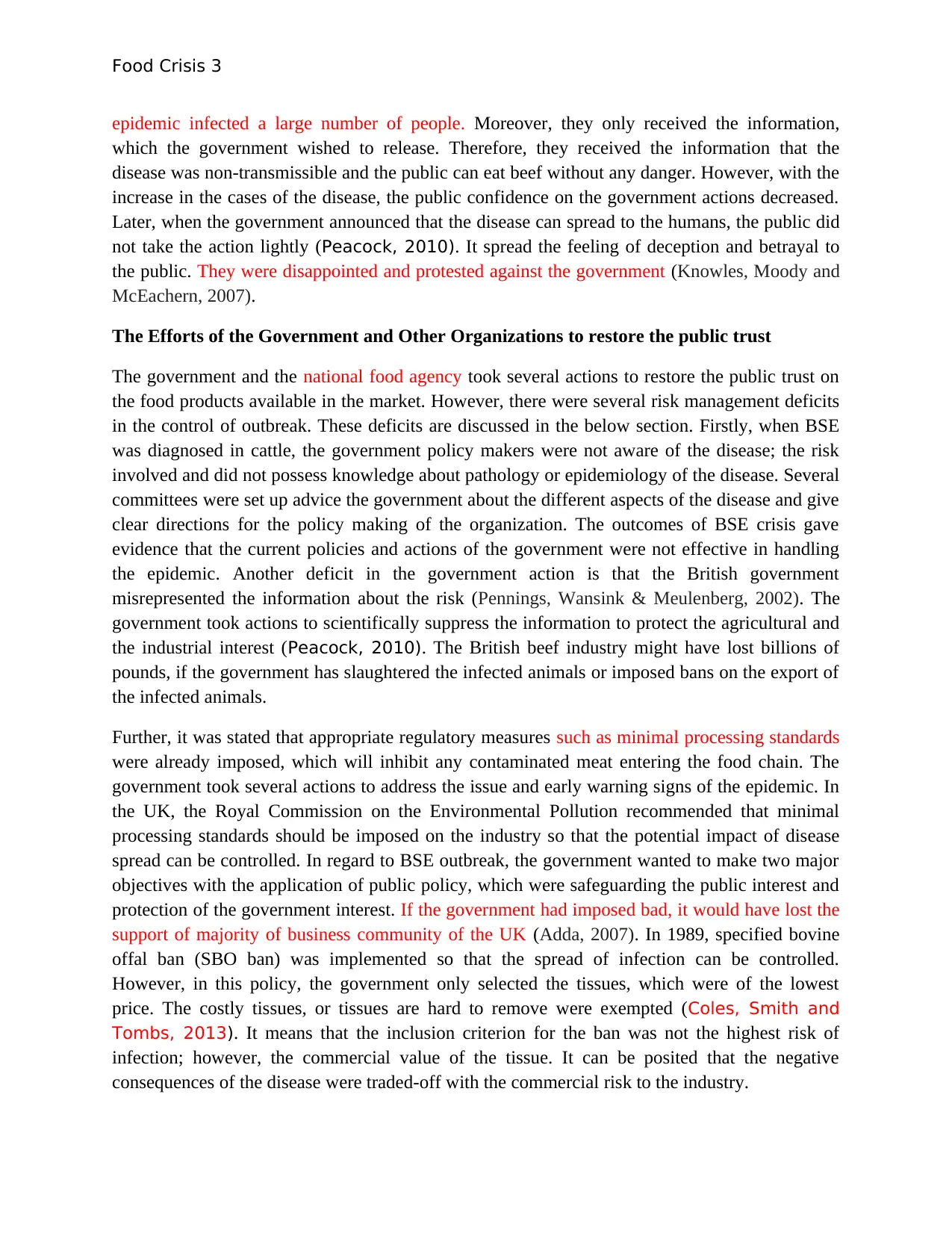
Food Crisis 3
epidemic infected a large number of people. Moreover, they only received the information,
which the government wished to release. Therefore, they received the information that the
disease was non-transmissible and the public can eat beef without any danger. However, with the
increase in the cases of the disease, the public confidence on the government actions decreased.
Later, when the government announced that the disease can spread to the humans, the public did
not take the action lightly (Peacock, 2010). It spread the feeling of deception and betrayal to
the public. They were disappointed and protested against the government (Knowles, Moody and
McEachern, 2007).
The Efforts of the Government and Other Organizations to restore the public trust
The government and the national food agency took several actions to restore the public trust on
the food products available in the market. However, there were several risk management deficits
in the control of outbreak. These deficits are discussed in the below section. Firstly, when BSE
was diagnosed in cattle, the government policy makers were not aware of the disease; the risk
involved and did not possess knowledge about pathology or epidemiology of the disease. Several
committees were set up advice the government about the different aspects of the disease and give
clear directions for the policy making of the organization. The outcomes of BSE crisis gave
evidence that the current policies and actions of the government were not effective in handling
the epidemic. Another deficit in the government action is that the British government
misrepresented the information about the risk (Pennings, Wansink & Meulenberg, 2002). The
government took actions to scientifically suppress the information to protect the agricultural and
the industrial interest (Peacock, 2010). The British beef industry might have lost billions of
pounds, if the government has slaughtered the infected animals or imposed bans on the export of
the infected animals.
Further, it was stated that appropriate regulatory measures such as minimal processing standards
were already imposed, which will inhibit any contaminated meat entering the food chain. The
government took several actions to address the issue and early warning signs of the epidemic. In
the UK, the Royal Commission on the Environmental Pollution recommended that minimal
processing standards should be imposed on the industry so that the potential impact of disease
spread can be controlled. In regard to BSE outbreak, the government wanted to make two major
objectives with the application of public policy, which were safeguarding the public interest and
protection of the government interest. If the government had imposed bad, it would have lost the
support of majority of business community of the UK (Adda, 2007). In 1989, specified bovine
offal ban (SBO ban) was implemented so that the spread of infection can be controlled.
However, in this policy, the government only selected the tissues, which were of the lowest
price. The costly tissues, or tissues are hard to remove were exempted (Coles, Smith and
Tombs, 2013). It means that the inclusion criterion for the ban was not the highest risk of
infection; however, the commercial value of the tissue. It can be posited that the negative
consequences of the disease were traded-off with the commercial risk to the industry.
epidemic infected a large number of people. Moreover, they only received the information,
which the government wished to release. Therefore, they received the information that the
disease was non-transmissible and the public can eat beef without any danger. However, with the
increase in the cases of the disease, the public confidence on the government actions decreased.
Later, when the government announced that the disease can spread to the humans, the public did
not take the action lightly (Peacock, 2010). It spread the feeling of deception and betrayal to
the public. They were disappointed and protested against the government (Knowles, Moody and
McEachern, 2007).
The Efforts of the Government and Other Organizations to restore the public trust
The government and the national food agency took several actions to restore the public trust on
the food products available in the market. However, there were several risk management deficits
in the control of outbreak. These deficits are discussed in the below section. Firstly, when BSE
was diagnosed in cattle, the government policy makers were not aware of the disease; the risk
involved and did not possess knowledge about pathology or epidemiology of the disease. Several
committees were set up advice the government about the different aspects of the disease and give
clear directions for the policy making of the organization. The outcomes of BSE crisis gave
evidence that the current policies and actions of the government were not effective in handling
the epidemic. Another deficit in the government action is that the British government
misrepresented the information about the risk (Pennings, Wansink & Meulenberg, 2002). The
government took actions to scientifically suppress the information to protect the agricultural and
the industrial interest (Peacock, 2010). The British beef industry might have lost billions of
pounds, if the government has slaughtered the infected animals or imposed bans on the export of
the infected animals.
Further, it was stated that appropriate regulatory measures such as minimal processing standards
were already imposed, which will inhibit any contaminated meat entering the food chain. The
government took several actions to address the issue and early warning signs of the epidemic. In
the UK, the Royal Commission on the Environmental Pollution recommended that minimal
processing standards should be imposed on the industry so that the potential impact of disease
spread can be controlled. In regard to BSE outbreak, the government wanted to make two major
objectives with the application of public policy, which were safeguarding the public interest and
protection of the government interest. If the government had imposed bad, it would have lost the
support of majority of business community of the UK (Adda, 2007). In 1989, specified bovine
offal ban (SBO ban) was implemented so that the spread of infection can be controlled.
However, in this policy, the government only selected the tissues, which were of the lowest
price. The costly tissues, or tissues are hard to remove were exempted (Coles, Smith and
Tombs, 2013). It means that the inclusion criterion for the ban was not the highest risk of
infection; however, the commercial value of the tissue. It can be posited that the negative
consequences of the disease were traded-off with the commercial risk to the industry.
Paraphrase This Document
Need a fresh take? Get an instant paraphrase of this document with our AI Paraphraser
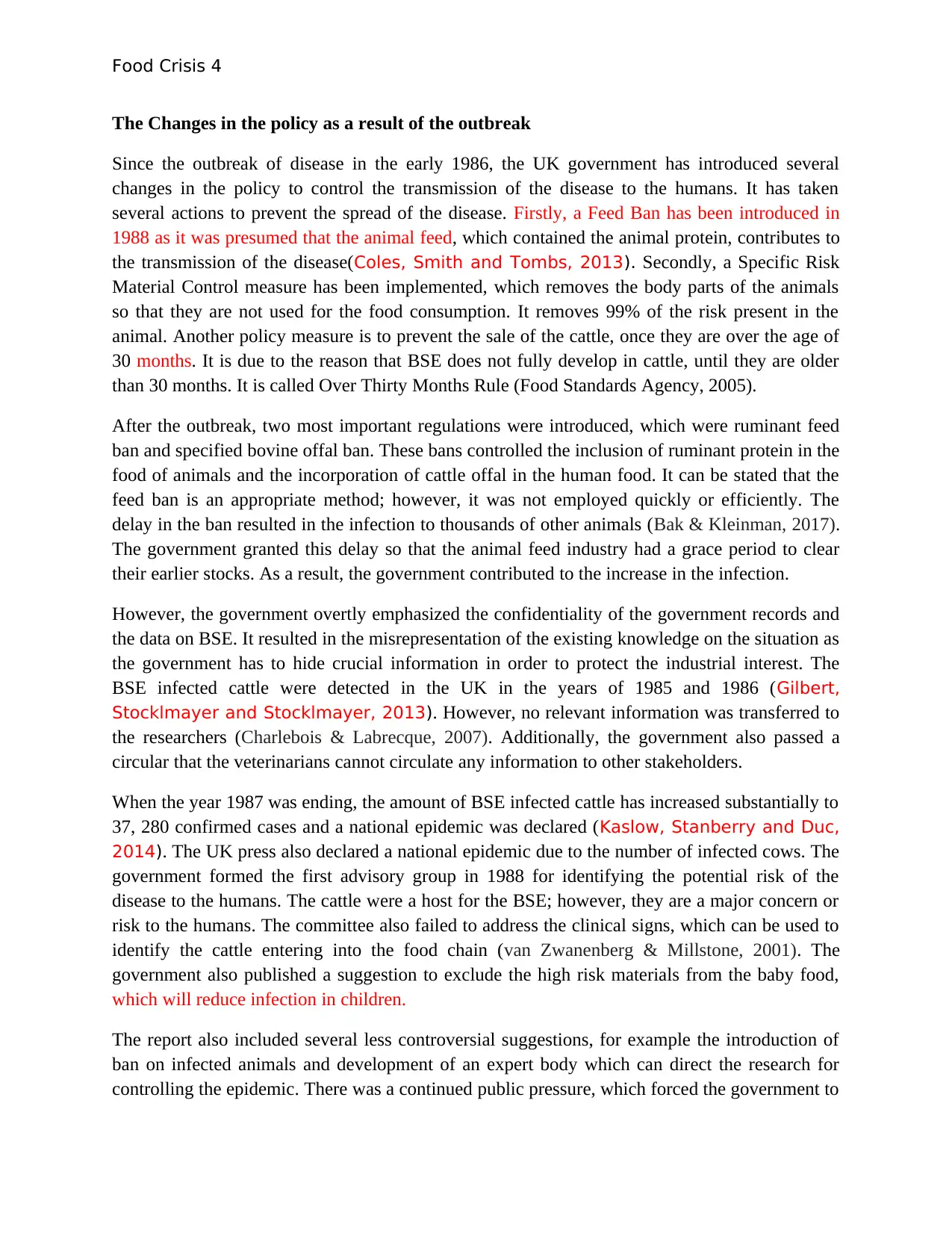
Food Crisis 4
The Changes in the policy as a result of the outbreak
Since the outbreak of disease in the early 1986, the UK government has introduced several
changes in the policy to control the transmission of the disease to the humans. It has taken
several actions to prevent the spread of the disease. Firstly, a Feed Ban has been introduced in
1988 as it was presumed that the animal feed, which contained the animal protein, contributes to
the transmission of the disease(Coles, Smith and Tombs, 2013). Secondly, a Specific Risk
Material Control measure has been implemented, which removes the body parts of the animals
so that they are not used for the food consumption. It removes 99% of the risk present in the
animal. Another policy measure is to prevent the sale of the cattle, once they are over the age of
30 months. It is due to the reason that BSE does not fully develop in cattle, until they are older
than 30 months. It is called Over Thirty Months Rule (Food Standards Agency, 2005).
After the outbreak, two most important regulations were introduced, which were ruminant feed
ban and specified bovine offal ban. These bans controlled the inclusion of ruminant protein in the
food of animals and the incorporation of cattle offal in the human food. It can be stated that the
feed ban is an appropriate method; however, it was not employed quickly or efficiently. The
delay in the ban resulted in the infection to thousands of other animals (Bak & Kleinman, 2017).
The government granted this delay so that the animal feed industry had a grace period to clear
their earlier stocks. As a result, the government contributed to the increase in the infection.
However, the government overtly emphasized the confidentiality of the government records and
the data on BSE. It resulted in the misrepresentation of the existing knowledge on the situation as
the government has to hide crucial information in order to protect the industrial interest. The
BSE infected cattle were detected in the UK in the years of 1985 and 1986 (Gilbert,
Stocklmayer and Stocklmayer, 2013). However, no relevant information was transferred to
the researchers (Charlebois & Labrecque, 2007). Additionally, the government also passed a
circular that the veterinarians cannot circulate any information to other stakeholders.
When the year 1987 was ending, the amount of BSE infected cattle has increased substantially to
37, 280 confirmed cases and a national epidemic was declared (Kaslow, Stanberry and Duc,
2014). The UK press also declared a national epidemic due to the number of infected cows. The
government formed the first advisory group in 1988 for identifying the potential risk of the
disease to the humans. The cattle were a host for the BSE; however, they are a major concern or
risk to the humans. The committee also failed to address the clinical signs, which can be used to
identify the cattle entering into the food chain (van Zwanenberg & Millstone, 2001). The
government also published a suggestion to exclude the high risk materials from the baby food,
which will reduce infection in children.
The report also included several less controversial suggestions, for example the introduction of
ban on infected animals and development of an expert body which can direct the research for
controlling the epidemic. There was a continued public pressure, which forced the government to
The Changes in the policy as a result of the outbreak
Since the outbreak of disease in the early 1986, the UK government has introduced several
changes in the policy to control the transmission of the disease to the humans. It has taken
several actions to prevent the spread of the disease. Firstly, a Feed Ban has been introduced in
1988 as it was presumed that the animal feed, which contained the animal protein, contributes to
the transmission of the disease(Coles, Smith and Tombs, 2013). Secondly, a Specific Risk
Material Control measure has been implemented, which removes the body parts of the animals
so that they are not used for the food consumption. It removes 99% of the risk present in the
animal. Another policy measure is to prevent the sale of the cattle, once they are over the age of
30 months. It is due to the reason that BSE does not fully develop in cattle, until they are older
than 30 months. It is called Over Thirty Months Rule (Food Standards Agency, 2005).
After the outbreak, two most important regulations were introduced, which were ruminant feed
ban and specified bovine offal ban. These bans controlled the inclusion of ruminant protein in the
food of animals and the incorporation of cattle offal in the human food. It can be stated that the
feed ban is an appropriate method; however, it was not employed quickly or efficiently. The
delay in the ban resulted in the infection to thousands of other animals (Bak & Kleinman, 2017).
The government granted this delay so that the animal feed industry had a grace period to clear
their earlier stocks. As a result, the government contributed to the increase in the infection.
However, the government overtly emphasized the confidentiality of the government records and
the data on BSE. It resulted in the misrepresentation of the existing knowledge on the situation as
the government has to hide crucial information in order to protect the industrial interest. The
BSE infected cattle were detected in the UK in the years of 1985 and 1986 (Gilbert,
Stocklmayer and Stocklmayer, 2013). However, no relevant information was transferred to
the researchers (Charlebois & Labrecque, 2007). Additionally, the government also passed a
circular that the veterinarians cannot circulate any information to other stakeholders.
When the year 1987 was ending, the amount of BSE infected cattle has increased substantially to
37, 280 confirmed cases and a national epidemic was declared (Kaslow, Stanberry and Duc,
2014). The UK press also declared a national epidemic due to the number of infected cows. The
government formed the first advisory group in 1988 for identifying the potential risk of the
disease to the humans. The cattle were a host for the BSE; however, they are a major concern or
risk to the humans. The committee also failed to address the clinical signs, which can be used to
identify the cattle entering into the food chain (van Zwanenberg & Millstone, 2001). The
government also published a suggestion to exclude the high risk materials from the baby food,
which will reduce infection in children.
The report also included several less controversial suggestions, for example the introduction of
ban on infected animals and development of an expert body which can direct the research for
controlling the epidemic. There was a continued public pressure, which forced the government to
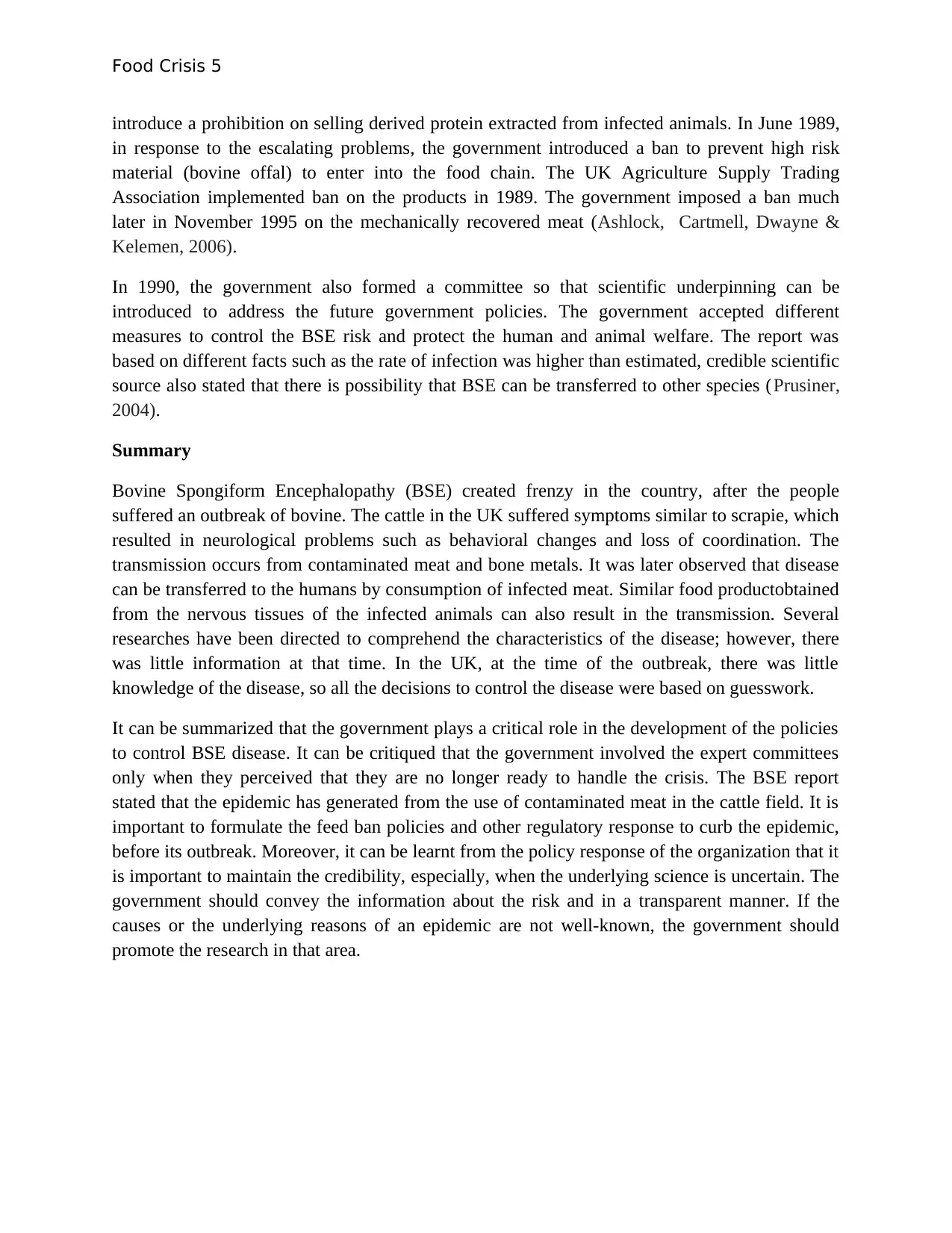
Food Crisis 5
introduce a prohibition on selling derived protein extracted from infected animals. In June 1989,
in response to the escalating problems, the government introduced a ban to prevent high risk
material (bovine offal) to enter into the food chain. The UK Agriculture Supply Trading
Association implemented ban on the products in 1989. The government imposed a ban much
later in November 1995 on the mechanically recovered meat (Ashlock, Cartmell, Dwayne &
Kelemen, 2006).
In 1990, the government also formed a committee so that scientific underpinning can be
introduced to address the future government policies. The government accepted different
measures to control the BSE risk and protect the human and animal welfare. The report was
based on different facts such as the rate of infection was higher than estimated, credible scientific
source also stated that there is possibility that BSE can be transferred to other species (Prusiner,
2004).
Summary
Bovine Spongiform Encephalopathy (BSE) created frenzy in the country, after the people
suffered an outbreak of bovine. The cattle in the UK suffered symptoms similar to scrapie, which
resulted in neurological problems such as behavioral changes and loss of coordination. The
transmission occurs from contaminated meat and bone metals. It was later observed that disease
can be transferred to the humans by consumption of infected meat. Similar food productobtained
from the nervous tissues of the infected animals can also result in the transmission. Several
researches have been directed to comprehend the characteristics of the disease; however, there
was little information at that time. In the UK, at the time of the outbreak, there was little
knowledge of the disease, so all the decisions to control the disease were based on guesswork.
It can be summarized that the government plays a critical role in the development of the policies
to control BSE disease. It can be critiqued that the government involved the expert committees
only when they perceived that they are no longer ready to handle the crisis. The BSE report
stated that the epidemic has generated from the use of contaminated meat in the cattle field. It is
important to formulate the feed ban policies and other regulatory response to curb the epidemic,
before its outbreak. Moreover, it can be learnt from the policy response of the organization that it
is important to maintain the credibility, especially, when the underlying science is uncertain. The
government should convey the information about the risk and in a transparent manner. If the
causes or the underlying reasons of an epidemic are not well-known, the government should
promote the research in that area.
introduce a prohibition on selling derived protein extracted from infected animals. In June 1989,
in response to the escalating problems, the government introduced a ban to prevent high risk
material (bovine offal) to enter into the food chain. The UK Agriculture Supply Trading
Association implemented ban on the products in 1989. The government imposed a ban much
later in November 1995 on the mechanically recovered meat (Ashlock, Cartmell, Dwayne &
Kelemen, 2006).
In 1990, the government also formed a committee so that scientific underpinning can be
introduced to address the future government policies. The government accepted different
measures to control the BSE risk and protect the human and animal welfare. The report was
based on different facts such as the rate of infection was higher than estimated, credible scientific
source also stated that there is possibility that BSE can be transferred to other species (Prusiner,
2004).
Summary
Bovine Spongiform Encephalopathy (BSE) created frenzy in the country, after the people
suffered an outbreak of bovine. The cattle in the UK suffered symptoms similar to scrapie, which
resulted in neurological problems such as behavioral changes and loss of coordination. The
transmission occurs from contaminated meat and bone metals. It was later observed that disease
can be transferred to the humans by consumption of infected meat. Similar food productobtained
from the nervous tissues of the infected animals can also result in the transmission. Several
researches have been directed to comprehend the characteristics of the disease; however, there
was little information at that time. In the UK, at the time of the outbreak, there was little
knowledge of the disease, so all the decisions to control the disease were based on guesswork.
It can be summarized that the government plays a critical role in the development of the policies
to control BSE disease. It can be critiqued that the government involved the expert committees
only when they perceived that they are no longer ready to handle the crisis. The BSE report
stated that the epidemic has generated from the use of contaminated meat in the cattle field. It is
important to formulate the feed ban policies and other regulatory response to curb the epidemic,
before its outbreak. Moreover, it can be learnt from the policy response of the organization that it
is important to maintain the credibility, especially, when the underlying science is uncertain. The
government should convey the information about the risk and in a transparent manner. If the
causes or the underlying reasons of an epidemic are not well-known, the government should
promote the research in that area.
⊘ This is a preview!⊘
Do you want full access?
Subscribe today to unlock all pages.

Trusted by 1+ million students worldwide
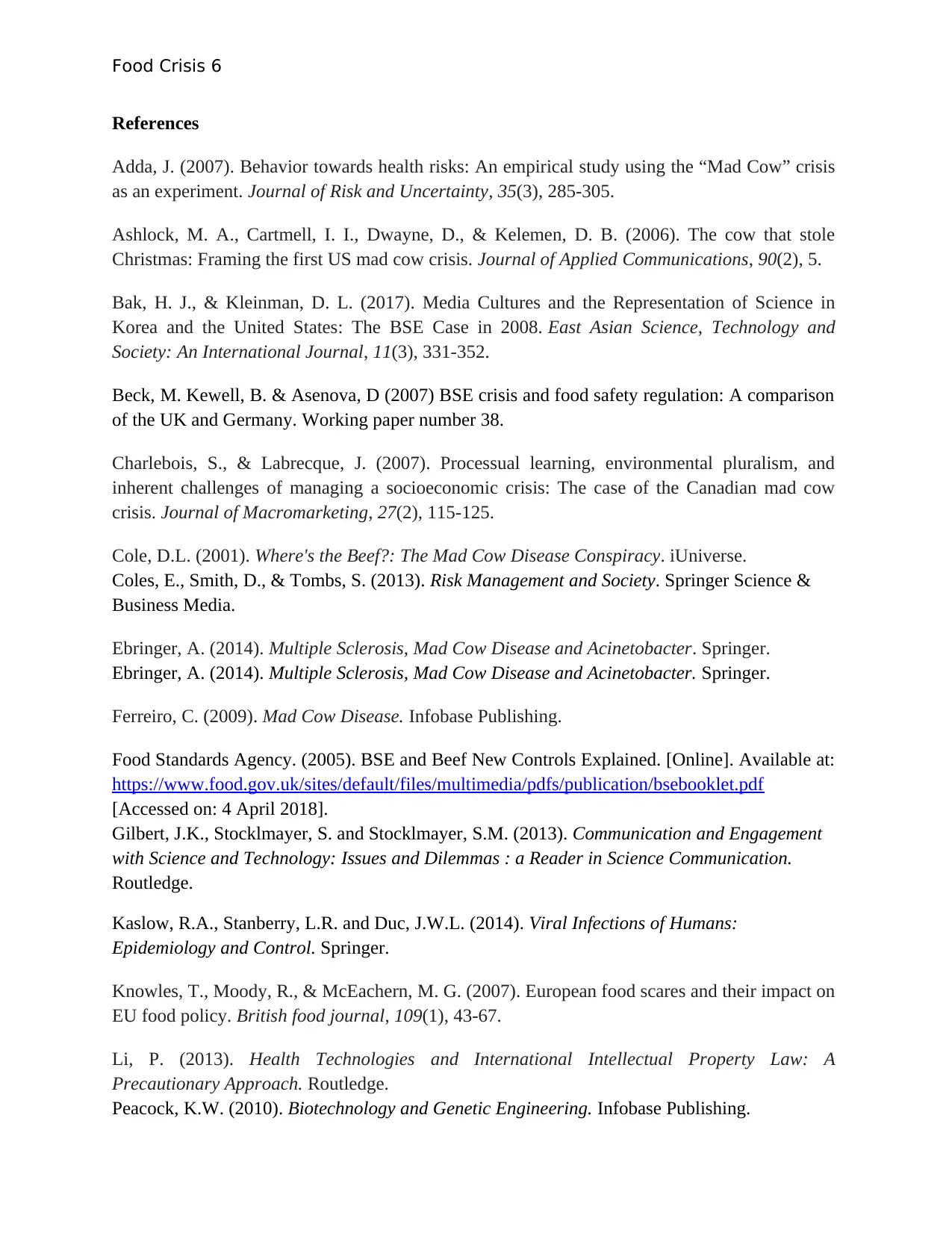
Food Crisis 6
References
Adda, J. (2007). Behavior towards health risks: An empirical study using the “Mad Cow” crisis
as an experiment. Journal of Risk and Uncertainty, 35(3), 285-305.
Ashlock, M. A., Cartmell, I. I., Dwayne, D., & Kelemen, D. B. (2006). The cow that stole
Christmas: Framing the first US mad cow crisis. Journal of Applied Communications, 90(2), 5.
Bak, H. J., & Kleinman, D. L. (2017). Media Cultures and the Representation of Science in
Korea and the United States: The BSE Case in 2008. East Asian Science, Technology and
Society: An International Journal, 11(3), 331-352.
Beck, M. Kewell, B. & Asenova, D (2007) BSE crisis and food safety regulation: A comparison
of the UK and Germany. Working paper number 38.
Charlebois, S., & Labrecque, J. (2007). Processual learning, environmental pluralism, and
inherent challenges of managing a socioeconomic crisis: The case of the Canadian mad cow
crisis. Journal of Macromarketing, 27(2), 115-125.
Cole, D.L. (2001). Where's the Beef?: The Mad Cow Disease Conspiracy. iUniverse.
Coles, E., Smith, D., & Tombs, S. (2013). Risk Management and Society. Springer Science &
Business Media.
Ebringer, A. (2014). Multiple Sclerosis, Mad Cow Disease and Acinetobacter. Springer.
Ebringer, A. (2014). Multiple Sclerosis, Mad Cow Disease and Acinetobacter. Springer.
Ferreiro, C. (2009). Mad Cow Disease. Infobase Publishing.
Food Standards Agency. (2005). BSE and Beef New Controls Explained. [Online]. Available at:
https://www.food.gov.uk/sites/default/files/multimedia/pdfs/publication/bsebooklet.pdf
[Accessed on: 4 April 2018].
Gilbert, J.K., Stocklmayer, S. and Stocklmayer, S.M. (2013). Communication and Engagement
with Science and Technology: Issues and Dilemmas : a Reader in Science Communication.
Routledge.
Kaslow, R.A., Stanberry, L.R. and Duc, J.W.L. (2014). Viral Infections of Humans:
Epidemiology and Control. Springer.
Knowles, T., Moody, R., & McEachern, M. G. (2007). European food scares and their impact on
EU food policy. British food journal, 109(1), 43-67.
Li, P. (2013). Health Technologies and International Intellectual Property Law: A
Precautionary Approach. Routledge.
Peacock, K.W. (2010). Biotechnology and Genetic Engineering. Infobase Publishing.
References
Adda, J. (2007). Behavior towards health risks: An empirical study using the “Mad Cow” crisis
as an experiment. Journal of Risk and Uncertainty, 35(3), 285-305.
Ashlock, M. A., Cartmell, I. I., Dwayne, D., & Kelemen, D. B. (2006). The cow that stole
Christmas: Framing the first US mad cow crisis. Journal of Applied Communications, 90(2), 5.
Bak, H. J., & Kleinman, D. L. (2017). Media Cultures and the Representation of Science in
Korea and the United States: The BSE Case in 2008. East Asian Science, Technology and
Society: An International Journal, 11(3), 331-352.
Beck, M. Kewell, B. & Asenova, D (2007) BSE crisis and food safety regulation: A comparison
of the UK and Germany. Working paper number 38.
Charlebois, S., & Labrecque, J. (2007). Processual learning, environmental pluralism, and
inherent challenges of managing a socioeconomic crisis: The case of the Canadian mad cow
crisis. Journal of Macromarketing, 27(2), 115-125.
Cole, D.L. (2001). Where's the Beef?: The Mad Cow Disease Conspiracy. iUniverse.
Coles, E., Smith, D., & Tombs, S. (2013). Risk Management and Society. Springer Science &
Business Media.
Ebringer, A. (2014). Multiple Sclerosis, Mad Cow Disease and Acinetobacter. Springer.
Ebringer, A. (2014). Multiple Sclerosis, Mad Cow Disease and Acinetobacter. Springer.
Ferreiro, C. (2009). Mad Cow Disease. Infobase Publishing.
Food Standards Agency. (2005). BSE and Beef New Controls Explained. [Online]. Available at:
https://www.food.gov.uk/sites/default/files/multimedia/pdfs/publication/bsebooklet.pdf
[Accessed on: 4 April 2018].
Gilbert, J.K., Stocklmayer, S. and Stocklmayer, S.M. (2013). Communication and Engagement
with Science and Technology: Issues and Dilemmas : a Reader in Science Communication.
Routledge.
Kaslow, R.A., Stanberry, L.R. and Duc, J.W.L. (2014). Viral Infections of Humans:
Epidemiology and Control. Springer.
Knowles, T., Moody, R., & McEachern, M. G. (2007). European food scares and their impact on
EU food policy. British food journal, 109(1), 43-67.
Li, P. (2013). Health Technologies and International Intellectual Property Law: A
Precautionary Approach. Routledge.
Peacock, K.W. (2010). Biotechnology and Genetic Engineering. Infobase Publishing.
Paraphrase This Document
Need a fresh take? Get an instant paraphrase of this document with our AI Paraphraser
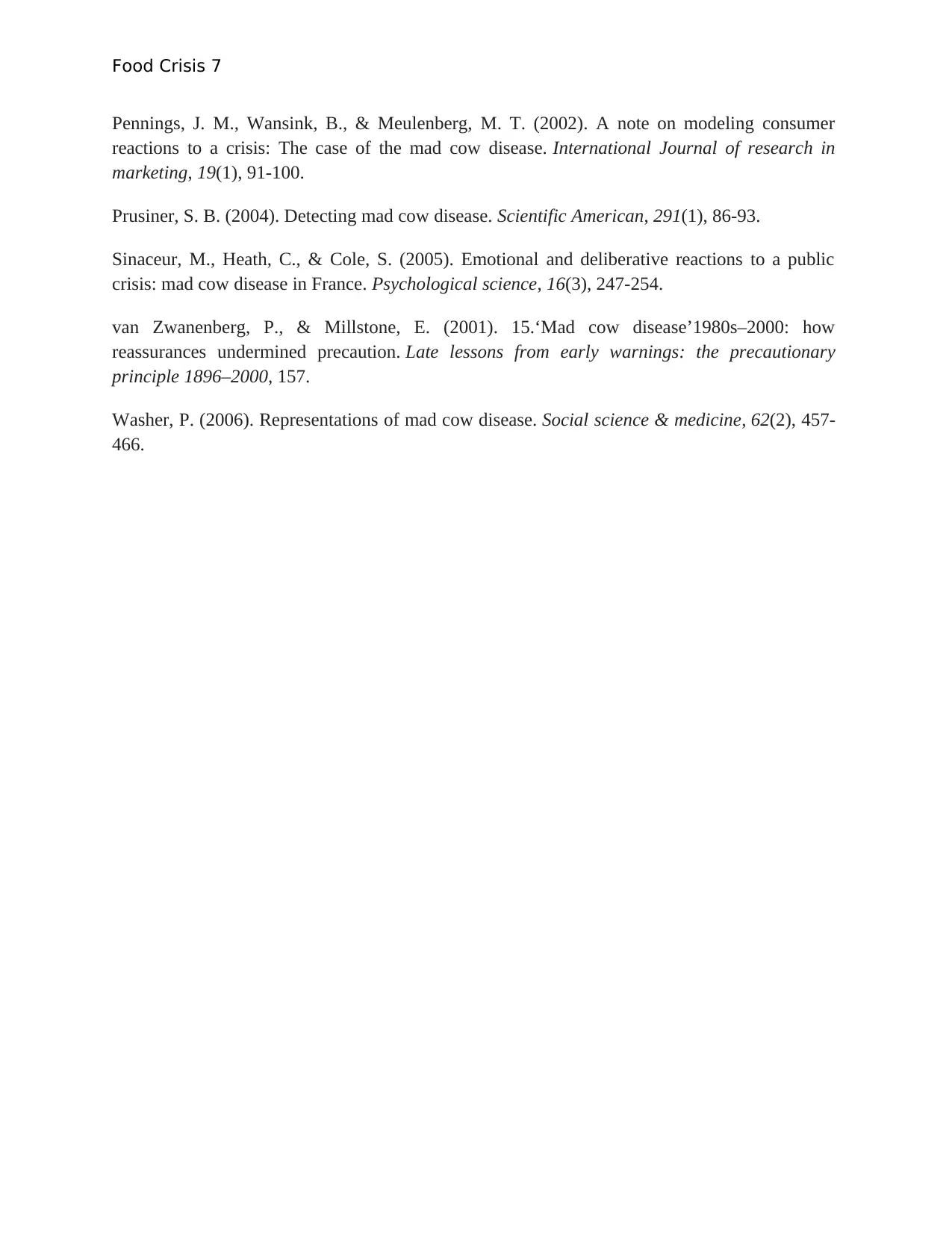
Food Crisis 7
Pennings, J. M., Wansink, B., & Meulenberg, M. T. (2002). A note on modeling consumer
reactions to a crisis: The case of the mad cow disease. International Journal of research in
marketing, 19(1), 91-100.
Prusiner, S. B. (2004). Detecting mad cow disease. Scientific American, 291(1), 86-93.
Sinaceur, M., Heath, C., & Cole, S. (2005). Emotional and deliberative reactions to a public
crisis: mad cow disease in France. Psychological science, 16(3), 247-254.
van Zwanenberg, P., & Millstone, E. (2001). 15.‘Mad cow disease’1980s–2000: how
reassurances undermined precaution. Late lessons from early warnings: the precautionary
principle 1896–2000, 157.
Washer, P. (2006). Representations of mad cow disease. Social science & medicine, 62(2), 457-
466.
Pennings, J. M., Wansink, B., & Meulenberg, M. T. (2002). A note on modeling consumer
reactions to a crisis: The case of the mad cow disease. International Journal of research in
marketing, 19(1), 91-100.
Prusiner, S. B. (2004). Detecting mad cow disease. Scientific American, 291(1), 86-93.
Sinaceur, M., Heath, C., & Cole, S. (2005). Emotional and deliberative reactions to a public
crisis: mad cow disease in France. Psychological science, 16(3), 247-254.
van Zwanenberg, P., & Millstone, E. (2001). 15.‘Mad cow disease’1980s–2000: how
reassurances undermined precaution. Late lessons from early warnings: the precautionary
principle 1896–2000, 157.
Washer, P. (2006). Representations of mad cow disease. Social science & medicine, 62(2), 457-
466.
1 out of 8
Your All-in-One AI-Powered Toolkit for Academic Success.
+13062052269
info@desklib.com
Available 24*7 on WhatsApp / Email
![[object Object]](/_next/static/media/star-bottom.7253800d.svg)
Unlock your academic potential
Copyright © 2020–2025 A2Z Services. All Rights Reserved. Developed and managed by ZUCOL.

